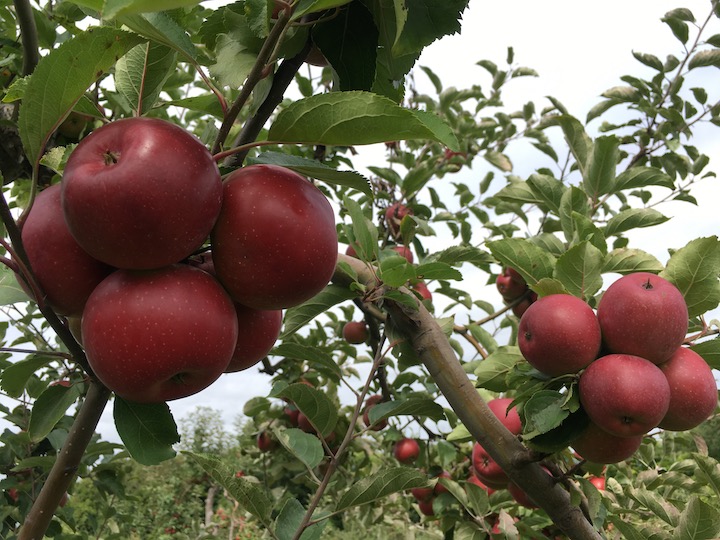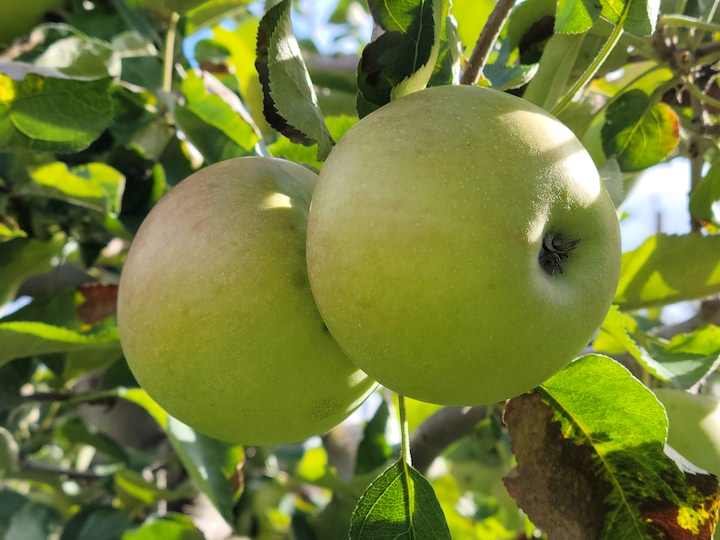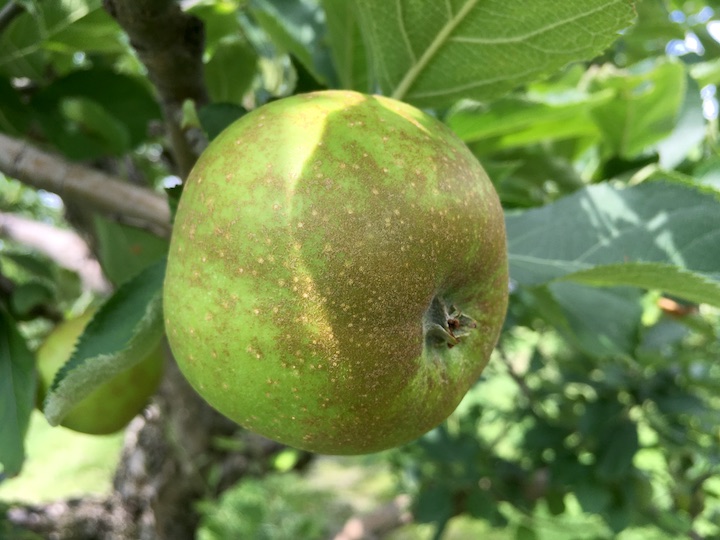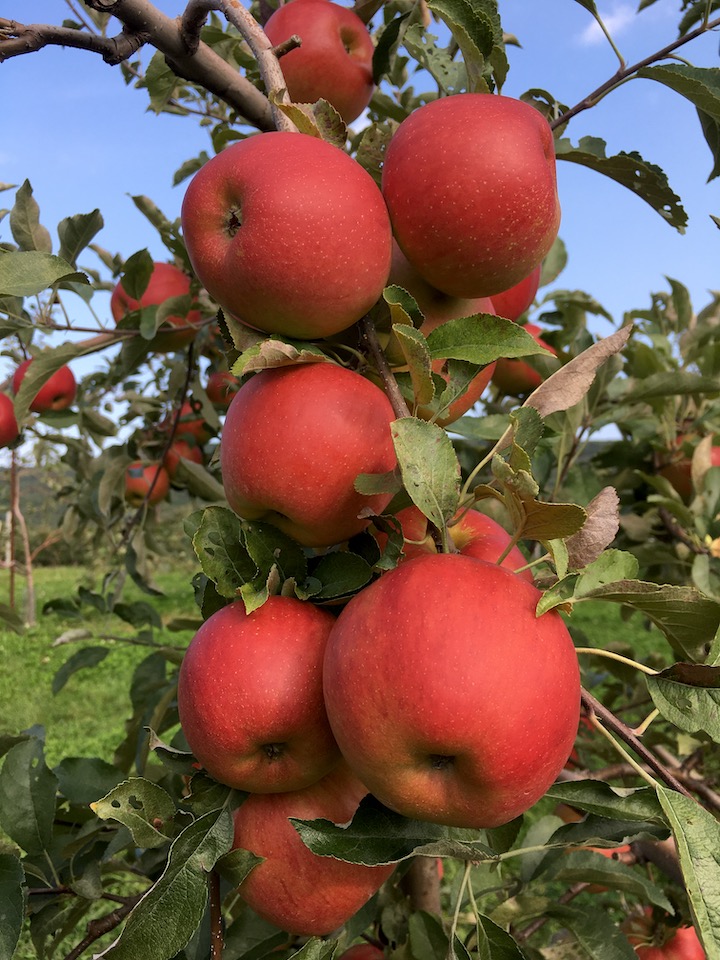
APPLE NAMES are as diverse — and informative and curious — as the fruit they describe.
Early marketers tried to distinguish their apples with superlatives, like the English heirloom Howgate Wonder (1915), and two Massachusetts varieties named for the towns in which they were discovered, both popular for much of the 1800s but little-grown today: Hubbardston Nonesuch and Westfield Seek-No-Further.
An imaginative name can’t save a middling apple, though. The early season Crow Egg is rarely seen now, and Cat’s Head may have disappeared altogether. Sheep’s Nose is mostly known for its distinctive shape.
Click on the name of any apple to see and read more about it.
We have Freedom (1958), Liberty (1978), and Enterprise (1990), developed for disease-resistance, not egalitarian ideals, recommended for the backyard gardener.
What names can top the English heirlooms Ribston Pippin, and two russeted apples, Ashmead’s Kernel and Pitmaston Pineapple, for mystery and intrigue? Their tales are as diverse and interesting as their taste.
All three varieties were discovered in the 1700s of unknown parentage and continue to beguile apple lovers today.
Ashmead Kernel has an orange blush and complex flavor, and is highly valued in cider. Ribston Pippin is a small apple better known as a parent of the richly flavored Cox’s Orange Pippin. Pitmaston Pineapple is even smaller, a delicious novelty the size of a golfball.
Ashmead was a doctor, Ribston and Pitmaston places, pineapple a rare flavor in a tiny apple. Kernel and pippin are synonyms for seed (pippin appears in a number of heirloom apple names).
Many contemporary varieties, in contrast, are good to eat but have compact names that describe values rather than people or places (or fruit, for that matter!): Fortune, Pristine, Spartan. Does the name burnish the apple? Or is it the other way around?
Others reference neither values nor apples: Corail (Pinova), Empire, Nova (Nova Spy). The practice of assigning names that have nothing to do with apples is not new, spanning generations: Spartan (1926); Empire (1945); Pristine (1975); and Corail (2000).

Some apple names honor pomologists, or the person who discovered them: Brock, from Maine, and two of New England’s most popular varieties today, spicy Macoun (a family name pronounced MacCOWan), and the iconic, red-green, sweet-tart McIntosh.

Other apples have multiple names or tell us where they came from: Rome (Rome Beauty, Red Rome), a chance seedling found in Rome Township along the banks of the Ohio river two centuries ago; and
Roxbury Russet, America’s first named variety, discovered in 1635 in what is now a neighborhood of Boston. It has been known by at least eight other names over the years, all including the word “russet” except for Leather Coat.
Several apples answer to the name Lady. There’s a Duchess, Empress, Mother, and Maiden; a King and a Deacon.
Some European apples are good to eat but mouthfuls to pronounce: Karmijn de Sonnaville, Zabergau Reinette. They are worth the effort when you find them!
Honeycrisp (1991), the most popular new variety of the past 50 years, has now been followed by Suncrisp (1994), CrimsonCrisp (2005), EverCrisp (2008), Autumn Crisp (2009), and the heavily marketed Washington-state apple Cosmic Crisp (2017), a variety that currently cannot be grown in New England orchards due to its restrictive trademark.

Is this trend because the word “crisp” allures consumers? Are marketers merely attempting to capitalize on Honeycrisp’s success?

Or is it sweetness people want, old (Tolman Sweet, 1700s) and new (Sweet Sixteen, 1973; SnowSweet, 2006)?
“Sweet” was common in early American apple names, when most apples were “spitters,” too sour or bitter to eat and grown primarily for cider.
An apple sweet enough for fresh eating was the exception, including Hightop Sweet (1600s) from Massachusetts; and
Connecticut apples Pumpkin Sweet (1830s), Ramsdell Sweet (1830s), Sheppard’s Sweet (1850s), Seaconk Sweeting (1860s).
They have interesting stories and filled a need at the time, but their flavor was mild and undistinguished compared to the apples of today.
Visit our Orchard Finder to see who grows what!

2 Comments
Elena Brandt
Such an informative article, Russell! May I remind you that you and Bar introduced me Honeycrisps?
Russell Powell
Thank you, Elena! There are some great Honeycrisp grown near you!